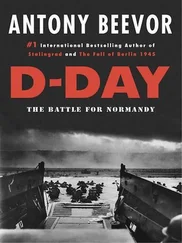Napoleon meanwhile gave five battalions of the Guard to Ney for the great assault, and rode to within 600 yards of Wellington’s line to salute them as they went into battle, and to acknowledge their loyal cries of ‘ Vive l’Empereur !’ Another three battalions formed a second wave but did not advance beyond La Haye Sainte. Of the rest of the Guard, two battalions were installed in Plancenoit, and there were a further two at La Belle Alliance and one at Le Caillou to cover a retreat if need be. The five battalions that were about to attack — two of grenadiers and three of chasseurs — were supported by the two corps under Reille and d’Erlon, as well as cuirassiers, Guard cavalry and horse artillery.
Wellington appears to have been well apprised of the coming blow, and he certainly used the fifteen minutes before it fell in setting out his dispositions in anticipation. It seems that a deserting French cavalry officer informed the commander of the Royal Horse Artillery, Lieutenant-Colonel Augustus Frazer, where and when the attack could be expected, information that was both accurate and credible. Wellington could have expected a major attack anyhow, but the knowledge of from where it would emanate allowed him to close up his line and place the reserve cavalry brigades under Vivian and Vandeleur in the best possible positions to deal with any breakthroughs.
The Guards battalions formed three lines as they advanced up the incline. They marched with their muskets sloped upon their shoulders, almost as if they were on parade at Fontainebleau rather than taking part in the last great military manoeuvre of a hard-fought battle, indeed the last French attack of the Napoleonic Wars. The advance, with the flying flags and the sound of fife and drum, has often been described as ‘unsurpassed’ and ‘sublime’in its initial discipline and pride. It must certainly have been an inspiring sight for a Frenchman, and a daunting one for those who stood waiting to receive its full force and fury. ? black mass of the grenadiers of the Imperial Guard,’ wrote one British observer, ‘with music playing and the great Napoleon at their head, came rolling onward from the farm of la Belle Alliance.’ 2
It is worth speculating here upon the exact nature of the slope up which the Imperial Guard had to attack, for we can be nearly certain that it was not the gentle gradient that may be walked on the site of the battlefield today. After the battle a 130-foot-high mound of earth was constructed by the Dutch to commemorate the wounding of the Prince of Orange, much to the disapproval of Wellington, who when he saw it complained, ‘They have ruined my battlefield.’ 3The earth for what is called the Lion Mound (after the vast stone lion atop it) was taken, it is believed, largely from the area to the north-west of it, thereby indeed wrecking the topography. Using geometric GPS satellite technology, topsoil analysis and a three-dimensional computer model, the landscape archaeologist Paul Hill has shown how there was almost certainly a relatively high ridge in 1815 that is not there today. Furthermore, there was a crop of high-standing corn that both slowed the Guard’s advance and gave the Anglo-Allied forces opportunities for concealment.
It was up to this ridge that the Guard advanced in columns at about 7.30 p.m., close to one another but with enough space apart for two cannon loaded with grapeshot to be drawn up too. The first column attacked at a point roughly midway between Hougoumont and La Haye Sainte. Ney led from the van, along with Generals Friant, Roguet and Michel, and had his fifth horse of the day shot from under him. Undeterred, ‘the bravest of the brave’ proceeded to advance on foot. As one historian has reconstructed the scene:
The sun was sinking, the darkened smoke-laden air made it very difficult to distinguish what was going on … Passing their emperor with their usual tremendous salute, the veterans hurried on, and threw themselves at Wellington’s line. 4
Waiting to receive them were more than thirty of Wellington’s cannon, primed with double grapeshot. At such close range it was hard to miss ranks of men so densely packed, and the Anglo-Allied artillery on the crest of the (largely now-missing) La Haye Sainte-Hougoumont ridge ripped huge holes in the French columns. Yet still the Guard came on. The 1st battalion of the 3rd Grenadiers soon overcame a Brunswick unit and captured the guns of Major William Lloyd’s Royal Artillery field brigade and Captain Cleeves’ King’s German Legion field brigade. They then began to engage Sir Colin Halkett’s brigade, pressing back the already badly-mauled 30th and 73rd Regiments.
The advance of the 3rd Grenadiers was halted, and eventually reversed, partly by the speed and courage of a Dutch brigade under General Baron David de Chassé, which Wellington had recalled from Braine l’Alleud as soon as he had recognised that Napoleon did not intend to mount any attacks beyond the Nivelles road on his right flank. Chassé deployed a Dutch-Belgian horse battery that volleyed grapeshot into the Guard, and then sent in 3,000 Dutch-Belgian infantry whose bayonets turned the grenadiers back down the slope. Never should the non-British and non-Prussian contribution to the victory be underestimated, since the repulse of the elite 1st/3rd Grenadiers of the Guard — a moment as important psychologically as it was tactically — was largely accomplished by these Dutch-Belgian troops. Just as it is an absurd question to ask whether Wellington could have won Waterloo without Blücher — because he would have never fought the battle — so it is equally pointless to consider a battle fought without the Dutch and Belgian contingents.
While Chassé was engaging the 3rd Grenadiers, the 4th Grenadiers of the Guard, reduced to a single battalion by its losses at Ligny two days earlier, attacked the right flank of Sir Colin Halkett’s brigade, supported by two guns of the Guard horse artillery reserve. The combined musket and grapeshot fire caused the British 33rd and 69th Regiments to waver, but any thought of retreat was banished by Halkett himself waving the flag of the 33rd above his head. Both regiments stood firm and the 4th Grenadiers were eventually also repulsed. Wellington’s centre had withstood the attack of the first Guard echelon, the grenadiers. Now was the time for the second and third echelons, made up of chasseurs.
Marching in two columns through and over the human and horseflesh debris of Ney’s futile cavalry attacks earlier in the day — ‘The ground was completely covered with those brave men, who lay in various positions, mutilated in every conceivable way’ 5— the three battalions of chasseurs also almost reached the crest of Wellington’s (today non-existent) ridge. They had been subjected to roundshot fire from the horse artillery troop formerly commanded by Major Norman Ramsay (who had been killed earlier in the day) from the moment they had formed up thousands of yards back near La Belle Alliance, but by the time they reached their destination their ammunition was getting scarce. Certainly the roared war-cries of the chasseurs could be easily heard over the boom of the cannon. Yet their formation was effectively split by the nature of the ridge, which is very apparent if one stands to the south of La Haye Sainte and advances north-north-west; visitors to the battlefield are encouraged to do this in order to appreciate the difficulties the Guard had in trying to stay together in this great assault.
As the 1st and 3rd Chasseurs à Pied of the Middle Guard mounted the crest in their attempt to reach the Ohain road — in some places they were only about twenty yards off — they were suddenly faced by the apparition of the British ist Foot Guards rising up from out of the corn where Wellington had hidden them. ‘Up Guards, ready!’is one of the many versions of the command that the Duke gave them as they presented their muskets and volleyed at almost point-blank range. Lieutenant Captain Harry Weyland Powell of the 1st Regiment of Foot Guards described the scene:
Читать дальше
Конец ознакомительного отрывка
Купить книгу











